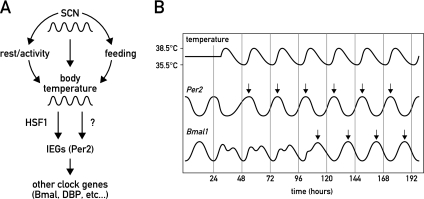Figure 7.
Model for the integration of body temperature rhythms in the synchronization of peripheral oscillators. (A) In mammals, the SCN regulates virtually all clock outputs, including rest/activity cycles, feeding/fasting cycles, and temperature rhythms. In peripheral cell types, elevated temperature induces HSF1 activity, which, in cooperation with other temperature-sensitive regulators, promotes the expression of immediate early genes (IEGs) such as Per2. In turn, the IEGs phase-reset other clock genes such as Bmal1 or Dbp. A direct action of temperature on the activity and stability of clock components may also occur. (B) Representative expression kinetics of Per2 versus Bmal1 in response to an altered body temperature rhythm. While Per2 expression immediately adapts to the temperature stimulus, Bmal1 expression requires few days to oscillate in resonance with the newly imposed phase.

